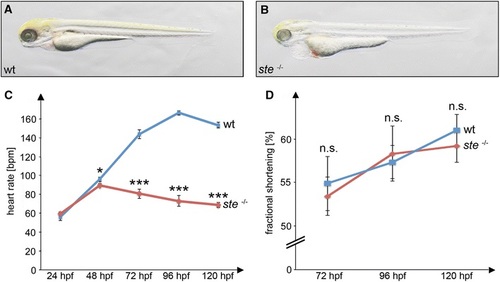Fig. 1
- ID
- ZDB-FIG-150408-48
- Publication
- Keßler et al., 2015 - Loss of dihydrolipoyl succinyltransferase (DLST) leads to reduced resting heart rate in the zebrafish
- Other Figures
- All Figure Page
- Back to All Figure Page
|
Effects of the ste mutation on cardiac function. a, b Lateral view of wild-type (wt) (a) and ste−/− mutant (b) embryos at 72 h post-fertilization (hpf). ste−/− mutants (b) develop blood congestion at the cardiac inflow tract and a pericardial edema. c Heart rate at different time points in ste−/− mutants (red) and wild-type littermates (blue). Bradycardia in ste−/− mutants starts at 48 hpf and becomes more severe during further embryonic development. d Ventricular fractional shortening is unaffected in ste−/− mutants compared to wild-type littermates at 72 hpf (53 ± 2.2 vs. 55 ± 3.1 %, n = 5, p = 0.7096), 96 hpf (58 ± 3.2 vs. 57 ± 1.9 %, n = 5, p = 0.7956) and 120 hpf (59 ± 1.9 vs. 61 ± 1.8 %, n = 5, p = 0.5586) |
| Fish: | |
|---|---|
| Observed In: | |
| Stage Range: | Protruding-mouth to Day 5 |

